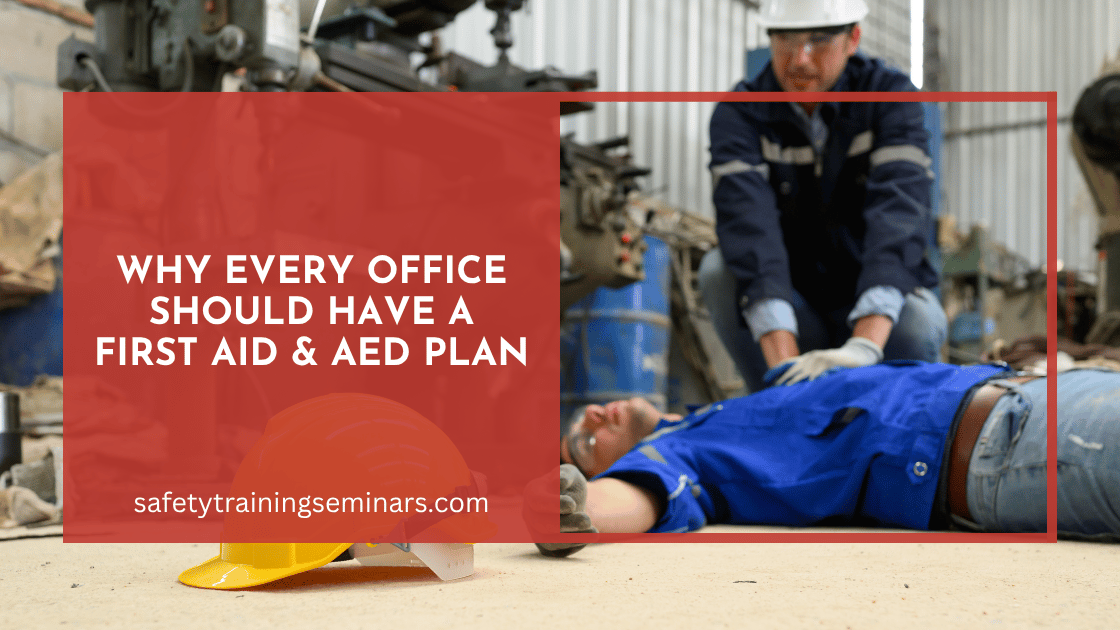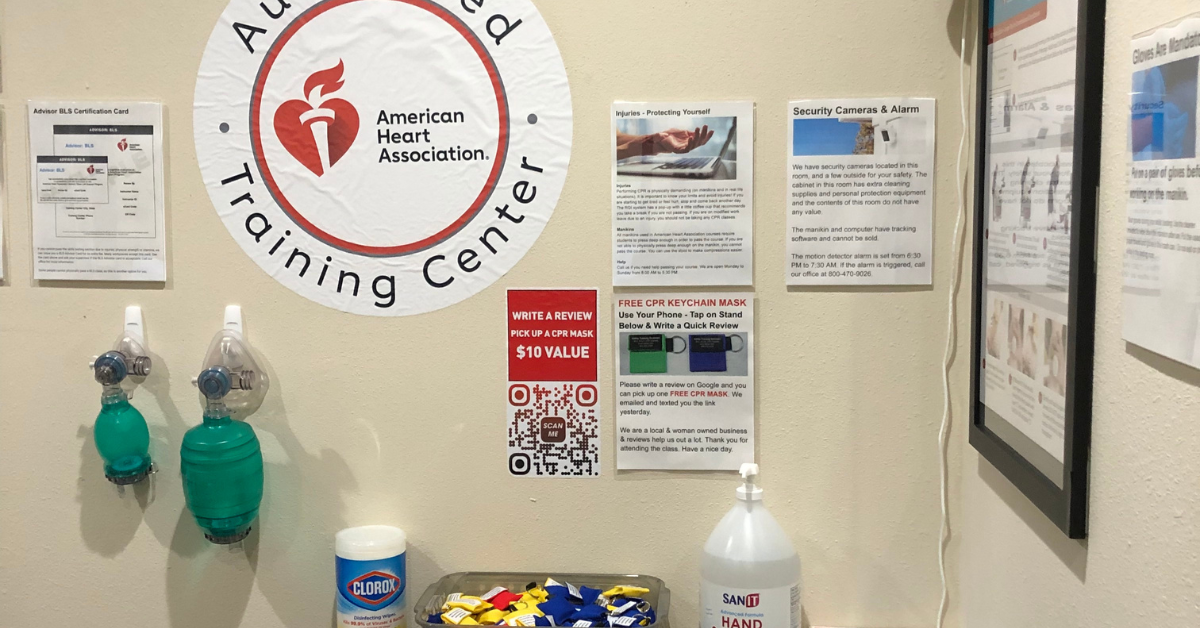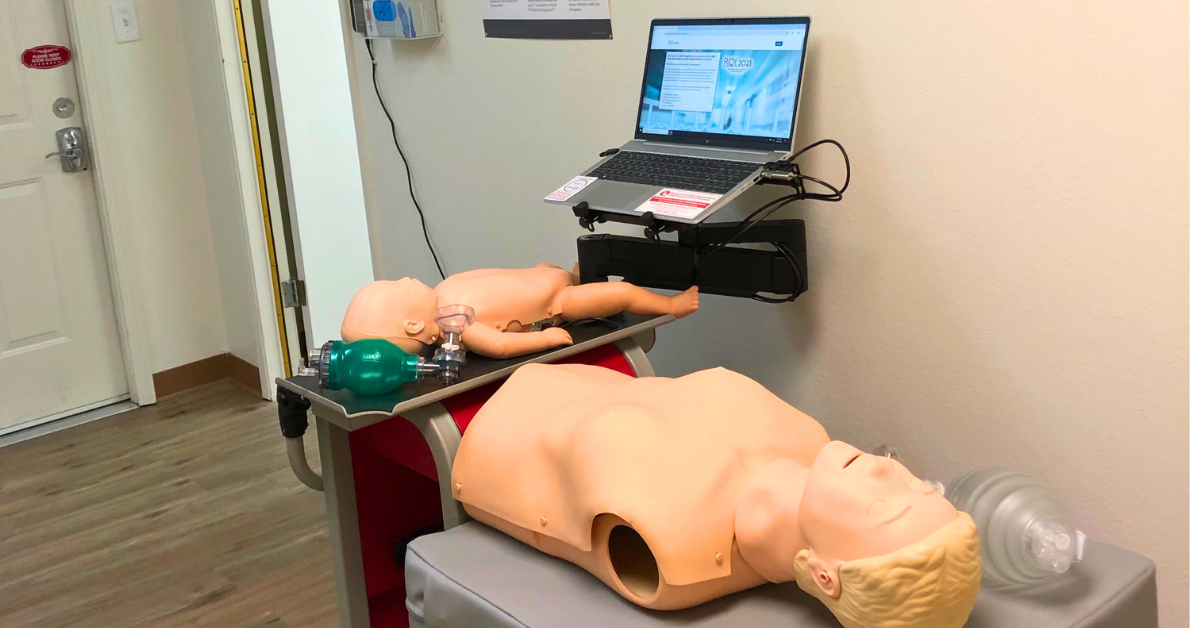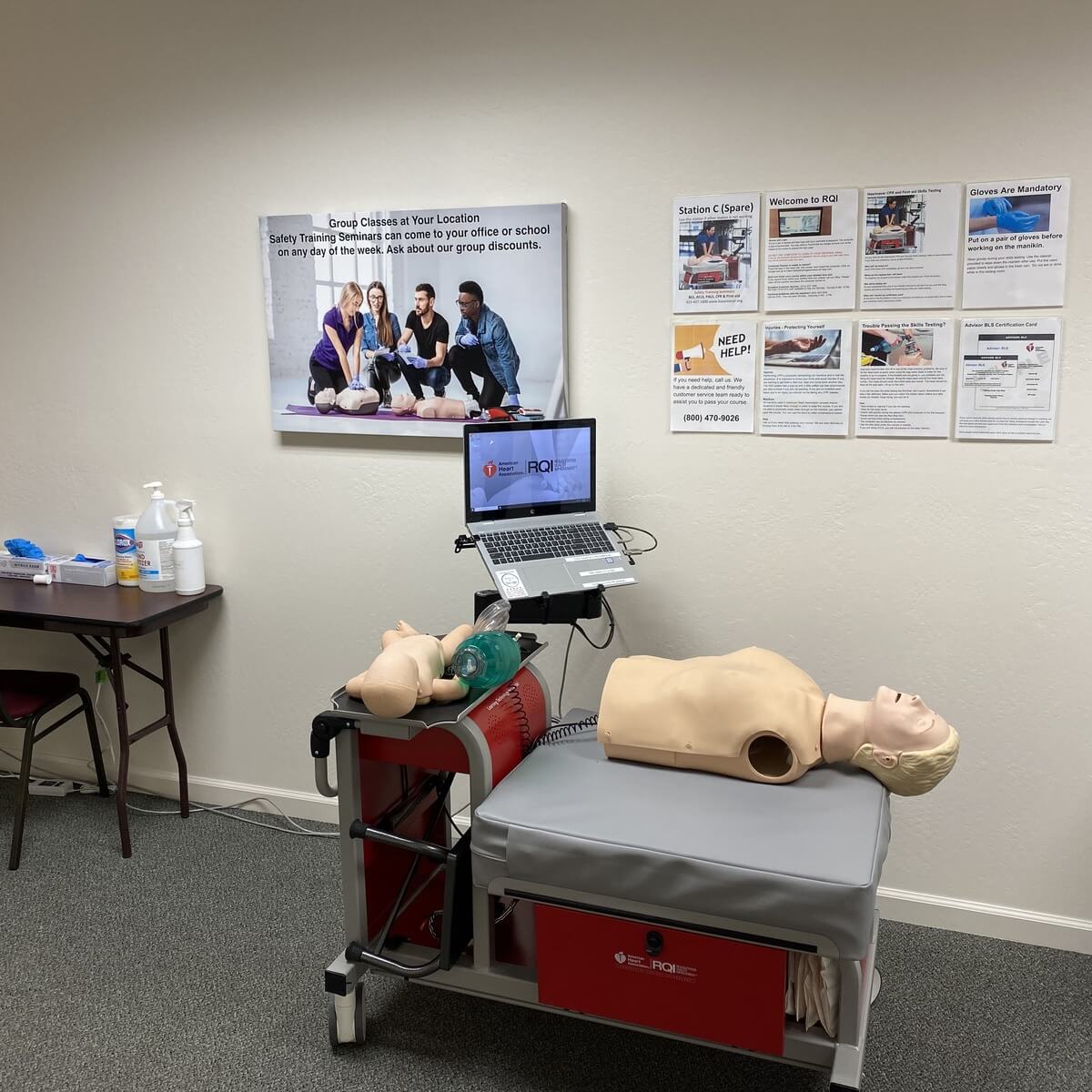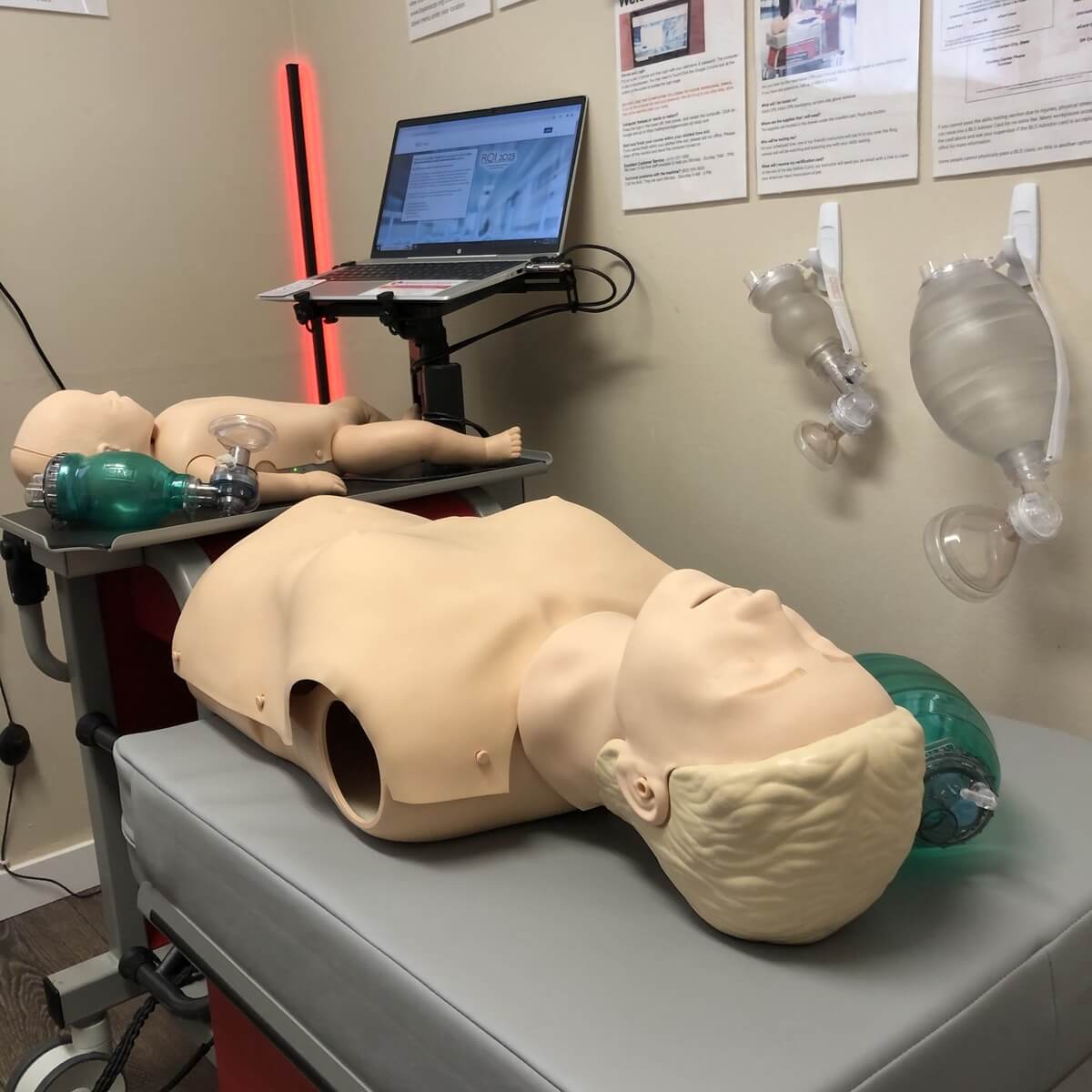Office emergencies don’t announce themselves. One moment your colleague is presenting quarterly results, the next they’re unconscious on the conference room floor. Without proper preparation, those crucial first minutes can mean the difference between life and death.
Every office needs a comprehensive first aid and AED plan. This isn’t just about compliance or checking boxes—it’s about creating a workplace where employees feel safe and protected. When cardiac emergencies strike, having trained staff and proper equipment can triple survival rates.
The statistics are sobering. Sudden cardiac arrest affects more than 350,000 Americans outside hospitals each year. In office buildings across the country, heart attacks, choking incidents, and severe injuries happen daily. Yet most workplaces remain unprepared for these life-threatening situations.
This guide will show you exactly why your office needs both first aid training and an automated external defibrillator (AED) program. We’ll explore the legal requirements, financial benefits, and practical steps to build a response plan that could save lives.
The Reality of Workplace Medical Emergencies
Medical emergencies in offices happen more frequently than most employers realize. The American Heart Association reports that workplace cardiac events account for approximately 10,000 deaths annually in the United States. These aren’t just statistics—they represent real people with families, dreams, and responsibilities.
Common office emergencies include sudden cardiac arrest, heart attacks, choking, severe allergic reactions, falls, cuts from office equipment, and diabetic emergencies. Each situation requires immediate action, and waiting for emergency medical services isn’t always an option.
Consider this scenario: An employee collapses during a morning meeting. Emergency medical services typically take 8-12 minutes to arrive in urban areas, and even longer in suburban office parks. For someone experiencing cardiac arrest, brain damage begins after just 4-6 minutes without oxygen. Every minute without CPR or defibrillation reduces survival chances by 7-10%.
The good news? Proper training and equipment can change these outcomes dramatically. Offices with AED programs and trained first aid responders see survival rates increase from less than 5% to over 40% for sudden cardiac arrest incidents.
Legal Requirements and Compliance Standards
Federal and state regulations increasingly require workplaces to maintain basic safety standards, including emergency medical response capabilities. The Occupational Safety and Health Administration (OSHA) mandates that employers provide medical and first aid personnel adequate to handle workplace injuries and illnesses.
OSHA’s requirements vary by workplace size and location. Companies with more than 150 employees, or those located more than 3-4 minutes from emergency medical services, must have trained first aid personnel available during working hours. Some states have stricter requirements, mandating AEDs in specific building types or occupancy levels.
California, New York, and several other states require AEDs in fitness centers, schools, and large office buildings. Local municipalities often add their own requirements. For example, many cities require buildings over a certain square footage to maintain AEDs and trained operators.
Beyond basic compliance, liability concerns make emergency preparedness essential. Companies face potential lawsuits when employees suffer preventable deaths or injuries due to inadequate emergency response. Insurance carriers increasingly offer premium discounts for workplaces with comprehensive emergency medical plans.
Professional licensing boards also influence requirements. Dental offices, medical practices, and healthcare-adjacent businesses must maintain specific first aid and emergency response capabilities to maintain their licenses.
Building Your First Aid Response Team
Creating an effective first aid response starts with identifying and training the right team members. Look for volunteers who remain calm under pressure, communicate clearly, and show genuine interest in helping others. Avoid assigning first aid duties based solely on job titles or seniority.
The ideal team size depends on your office layout and employee count. Small offices need at least two trained responders to ensure coverage during breaks, meetings, and sick days. Larger workplaces should aim for one trained responder per 25-30 employees, distributed across different floors and departments.
Training options include Basic Life Support (BLS) for healthcare workers, CPR/AED certification for general employees, and comprehensive first aid courses covering common workplace injuries. The American Heart Association, American Red Cross, and other certified providers offer courses lasting 2-8 hours depending on the certification level.
BLS certification covers high-quality CPR for adults, children, and infants, AED operation, and team dynamics during emergencies. This intensive training is ideal for office medical professionals or designated safety officers. Courses typically require 1-2 hours of online learning plus 30 minutes of hands-on skills testing.
Heartsaver CPR and First Aid certification targets general employees and covers basic CPR, AED use, choking relief, and common injury management. The course combines 1-2 hours of online learning with 30-45 minutes of practical skills assessment.
Regular refresher training maintains skills and confidence. Most certifications expire after two years, but quarterly practice sessions help responders stay sharp. Many training providers offer group rates for workplace programs, making ongoing education affordable.
Essential Equipment and Supply Management
Every office first aid plan requires proper equipment, starting with a well-stocked first aid kit. Basic kits should include adhesive bandages, gauze pads, medical tape, antiseptic wipes, instant cold packs, disposable gloves, scissors, and emergency contact information.
Expand your kit based on specific workplace risks. Offices with kitchens need burn treatment supplies. Companies with workshops or manufacturing areas require eye wash stations and trauma dressings. Multi-story buildings should maintain first aid stations on each floor.
AED selection requires careful consideration of your office environment and budget. Modern AEDs are designed for lay rescuer use, with voice prompts guiding users through each step. Look for devices with pediatric capabilities, long battery life, and simple maintenance requirements.
Popular AED models include the Philips HeartStart OnSite, Zoll AED Plus, and Cardiac Science Powerheart G5. Features to consider include automatic shock delivery, rescue coaching, dual-language capabilities, and connectivity for emergency services notification.
AED placement follows specific guidelines for maximum effectiveness. Install devices in central locations with high foot traffic, clearly marked signage, and 24/7 accessibility. Avoid areas with extreme temperatures, moisture, or electromagnetic interference. The goal is reaching any location in your office within 90 seconds.
Supply management systems ensure equipment remains functional when needed. Assign specific staff members to check expiration dates monthly, test AED functionality quarterly, and restock supplies after any use. Many providers offer automatic replacement services for expiring items.
Creating Your Emergency Response Protocol
Effective emergency response requires clear protocols that anyone can follow under stress. Start with a simple chain of command identifying who takes charge during medical emergencies, who calls 911, and who provides first aid care.
Your protocol should address different emergency types with specific response steps. For cardiac arrest: call 911 immediately, begin CPR, retrieve and apply the AED, and continue care until emergency services arrive. For choking: determine if the person can speak or cough, perform abdominal thrusts if needed, and call 911 if the person becomes unconscious.
Communication systems must function during emergencies. Designate backup personnel for key roles, establish methods for notifying building security and management, and create systems for directing emergency services to the exact location.
Documentation requirements vary by jurisdiction but typically include incident reports, witness statements, and medical care provided. Templates help responders collect necessary information while memories remain fresh.
Practice scenarios build confidence and reveal protocol weaknesses. Conduct quarterly drills testing different emergency types and locations. Include timing exercises to ensure AED retrieval meets the critical 3-4 minute window.
Recovery procedures often get overlooked but remain crucial. Plans should address cleanup, equipment inspection and restocking, employee counseling resources, and incident review processes.
Training Your Entire Staff
While designated responders provide hands-on care, every employee should understand basic emergency procedures. Company-wide training covers recognizing medical emergencies, activating the emergency response system, and supporting trained responders.
Recognition training helps employees identify common medical emergencies. Signs of cardiac arrest include sudden collapse, no response to verbal stimuli, and absent or abnormal breathing. Heart attack symptoms can be subtler: chest pain or discomfort, shortness of breath, nausea, and sweating.
Choking recognition requires understanding the difference between partial and complete airway obstruction. Someone with partial obstruction can still speak or cough and should be encouraged to continue coughing. Complete obstruction requires immediate intervention with back blows and abdominal thrusts.
Allergic reaction severity varies dramatically. Mild reactions cause localized swelling, itching, or hives. Severe anaphylaxis produces difficulty breathing, widespread swelling, rapid pulse, and loss of consciousness. Employees should know when to use epinephrine auto-injectors and how to assist trained responders.
Communication protocols ensure fast, accurate information flow during emergencies. Train employees to provide clear location information when calling 911, including building address, floor number, and specific room or area. Designate someone to meet emergency services at the building entrance.
Support roles help trained responders focus on patient care. Untrained employees can clear the area, retrieve equipment, document the incident, and provide emotional support to witnesses.
Cost-Benefit Analysis
Implementing a comprehensive first aid and AED program requires upfront investment but delivers significant long-term value. Initial costs include equipment purchase, training fees, and staff time for certification.
AED costs range from $1,200-$2,500 per unit, depending on features and brand. First aid supplies typically cost $100-$300 for initial stocking, with annual restocking costs of $50-$100. Training expenses vary by provider and certification level, averaging $50-$150 per employee.
Calculate ongoing costs including recertification every two years, supply replacement, equipment maintenance, and administrative time. Most offices can implement comprehensive programs for $2,000-$5,000 initially, with annual costs of $500-$1,000.
The financial benefits justify these investments through multiple channels. Workers’ compensation savings result from faster, more effective emergency response reducing injury severity and recovery time. Insurance premium discounts reward proactive safety programs.
Legal protection provides enormous value. Documented emergency response capabilities demonstrate reasonable care standards, reducing liability exposure. The cost of a single wrongful death lawsuit far exceeds any program investment.
Employee retention and recruitment benefits are harder to quantify but equally valuable. Workers appreciate employers who prioritize their safety and well-being. Safety-conscious companies attract top talent and experience lower turnover rates.
Productivity gains come from reduced absenteeism due to workplace injuries and faster return-to-work times when incidents do occur. Employees feel more confident and secure knowing their workplace can handle medical emergencies.
Implementation Timeline and Milestones
Rolling out your first aid and AED program requires careful planning and realistic timelines. Phase your implementation to ensure thoroughness while maintaining business operations.
Months 1-2: Planning and Assessment
Conduct workplace risk assessments identifying potential hazards and high-risk areas. Research local training providers and compare certification options. Develop budget proposals and secure management approval.
Months 3-4: Equipment and Personnel
Purchase AEDs and first aid supplies based on your assessment. Install equipment in designated locations with proper signage. Recruit volunteer responders and schedule initial training sessions.
Months 5-6: Training and Protocol Development
Complete responder certifications and begin company-wide awareness training. Develop written emergency response protocols and communication procedures. Create documentation templates and reporting systems.
Months 7-8: Testing and Refinement
Conduct initial emergency drills to test protocols and equipment. Gather feedback from participants and refine procedures. Complete any additional training needs identified during testing.
Ongoing: Maintenance and Improvement
Establish regular maintenance schedules for equipment inspection and supply restocking. Schedule recertification training as expiration dates approach. Review and update protocols annually based on experience and regulatory changes.
Success metrics help track program effectiveness. Monitor response times from incident recognition to AED application. Track training completion rates and maintain certification databases. Document any real emergencies and analyze response effectiveness.
Measuring Success and Continuous Improvement
Effective first aid and AED programs require ongoing evaluation and improvement. Establish key performance indicators that demonstrate program value and identify areas needing attention.
Response time metrics measure how quickly your team can deploy during actual emergencies. Track time from incident recognition to first aid initiation, AED retrieval and application, and emergency services arrival. Aim for AED deployment within 3-4 minutes of cardiac arrest recognition.
Training compliance rates indicate program engagement and readiness levels. Monitor initial certification completion, recertification timing, and participation in refresher sessions. Maintain databases tracking expiration dates and scheduling requirements.
Equipment readiness involves regular functionality checks and maintenance records. AEDs should undergo monthly visual inspections, battery level checks, and electrode pad expiration monitoring. First aid supplies need regular inventory and restocking.
Incident documentation provides valuable learning opportunities. Record every emergency response, including actions taken, response times, and outcomes. Analyze patterns to identify training needs or protocol improvements.
Employee feedback helps gauge program effectiveness and acceptance. Conduct annual surveys measuring confidence levels, training quality, and perceived safety improvements. Use feedback to adjust training content and delivery methods.
Regular program reviews with management ensure continued support and resource allocation. Present annual reports highlighting training statistics, incident responses, cost savings, and regulatory compliance. Demonstrate return on investment through concrete examples and testimonials.
Taking Action Today
Your office’s first aid and AED plan shouldn’t wait for tomorrow. Every day without proper emergency response capabilities puts your employees at unnecessary risk. The steps to implementation are straightforward, and the resources are readily available.
Start by assessing your current emergency preparedness. Identify gaps in training, equipment, and protocols. Research certified training providers in your area and compare program options. Many organizations offer group discounts and on-site training that minimizes disruption to business operations.
Contact certified training centers like Safety Training Seminars, which offer American Heart Association courses with guaranteed pass rates and same-day certification. Our programs cover everything from basic CPR and AED use to advanced life support for healthcare professionals.
Remember that implementing a first aid and AED program isn’t just about meeting legal requirements—it’s about creating a culture of safety and care that benefits everyone. When employees know their workplace is prepared for emergencies, they feel valued and protected.
The investment in training and equipment pays dividends in employee morale, legal protection, and potentially saved lives. Don’t wait for an emergency to reveal the gaps in your current preparedness. Take action today to build a comprehensive first aid and AED program that could make all the difference when seconds count.


